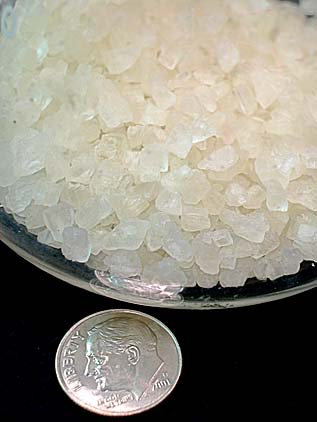
CRAIG T. KOJIMA / CKOJIMA@STARBULLETIN.COM
A Honolulu police officer holds a gram of "ice," which is worth between $200 and $300. Recipes for making ice vary, but the main ingredient is ephedrine.
Use of methamphetamine
dates to early 1900s in Japan
Crystal methamphetamine, or "ice," is a concentrated derivative of its parent drug, methamphetamine, which was first synthesized in Japan in 1919.
As early as 1932, meth was used as a nasal decongestant and was one of the first antidepressants.
During World War II, historians say, soldiers took methamphetamine to fight fatigue and reduce hunger. The drug was used by American and British fighter pilots, German tank troops, and Japanese soldiers and workers.
According to a study by Richard Rawson, associate director of the University of California at Los Angeles Integrated Substance Abuse Program, Japan produced large stockpiles of meth during and after World War II. Rawson said that after World War II, an estimated 3 percent to 4 percent of Japan's population was addicted, before occupying Allies eliminated the drug's use.
The Japanese collected the first data on the long-term effects of using the drug and found that 5 percent to 7 percent sustained long-term psychoses, he said.
During the 1950s and 1960s, Swedish clinics used meth as a treatment for heroin addiction, much the same way methadone has been used in the United States. Doctors quit the treatments after recognizing that patients developed psychoses on relatively low doses of the drug.
During the late 1960s and early 1970s, pharmaceutical companies in the United States introduced meth as a prescription drug for weight loss.
CRAIG T. KOJIMA / CKOJIMA@STARBULLETIN.COM
Crystal methamphetamine.
What is it?
Crystal methamphetamine is a highly addictive, central nervous system stimulant that can be made from products easily available at a Longs Drug Store, according to data from the National Drug Intelligence Center of the Department of Justice.Recipes for meth vary, but the central ingredient is ephedrine or even pseudoephedrine, commonly found in over-the-counter cold medicines and diet pills.
While ephedrine tablets are widely available in Asia and Mexico, which are some of the biggest producers of meth, they are harder to find in the United States. Since 1990, the federal Food and Drug Administration has warned consumers against products containing ephedrine because the stimulant can cause problems including heart attacks, seizures and strokes. Most drug stores no longer carry products containing ephedrine.
Depending on the recipe, other ingredients used to make meth can be found in lithium camera batteries, matches, tincture of iodine and hydrogen peroxide. Some recipes also use ingredients such as charcoal lighter fluid, paint thinner, gasoline, kerosene, rubbing alcohol and mineral spirits.
Corrosive products are used during the "cooking process," such as sulfuric acid in battery acid or sodium hydroxide from lye-based drain cleaners.
Crystal methamphetamine requires an added step to convert powder meth to crystals. Ice is most often produced by dissolving the powder with a solvent such as methanol, acetone, ethanol or isopropanol and then slowly letting it recrystallize.
BACK TO TOP |
Crystal meth crime
statistics for OahuIce arrests
Year Cases/arrests 1999 583/497 2000 699/480 2001 630/514 2002 616/485 2003 (January-July only) 574/357
Ice seizures
Year Amount 2001 26,680 grams 2002 40,510 grams 2003 (Jan - July) 33,903 grams
Source: Honolulu Police Department, Narcotics/Vice Division


